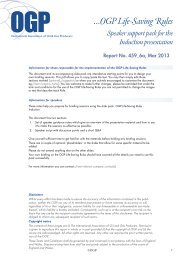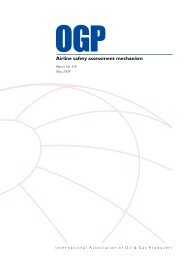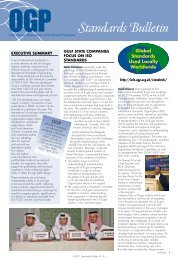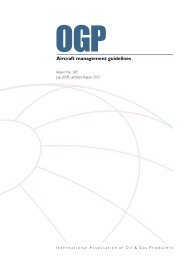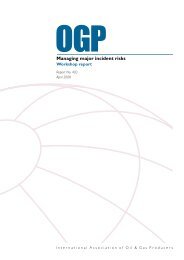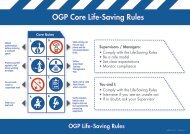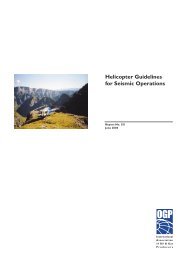Helicopter guidelines for land seismic & helirig operations - OGP
Helicopter guidelines for land seismic & helirig operations - OGP
Helicopter guidelines for land seismic & helirig operations - OGP
Create successful ePaper yourself
Turn your PDF publications into a flip-book with our unique Google optimized e-Paper software.
International Association of Oil & Gas Producers<br />
F.2 Line helipads in desert areas<br />
While the selection of a suitable <strong>land</strong>ing area adjacent to the <strong>seismic</strong> line is unlikely to present<br />
great problems, precautions must be taken to prevent damage to helicopter engines and rotor<br />
blades due to sand erosion. Invariably, the helicopters will be specified with suitable sand<br />
reduction modifications. However, some preparation may be required at temporary <strong>land</strong>ing<br />
sites; a simple remedy would be to suppress the sand with water.<br />
Note: Erosion of helicopter engine compressor turbine blades can be dramatic if suitable<br />
precautions are not taken.<br />
F.3 Line helipads in mountainous areas<br />
Seismic parties in areas of mountainous terrain will often require the support of helicopters.<br />
The per<strong>for</strong>mance specification of the helicopters must be such that it is suitable <strong>for</strong> mountain<br />
<strong>operations</strong>. Mountain flying, particularly at high altitudes, presents a pilot with special problems,<br />
demanding a close study of the aircraft limitations and per<strong>for</strong>mance graphs and interpretation<br />
of local wind and turbulence effects caused by topographical features.<br />
When undulations in the terrain are relatively smooth, or where the wind velocity is low, a<br />
laminar air flow can be expected, giving a gentle up-draught on the windward slope of a hill or<br />
mountain and a corresponding down-draught on the leeward side. Where the terrain contours<br />
are abrupt or jagged or the wind velocity high, the effects are less predictable, as a turbulent<br />
airflow will occur, both over and around the obstructions; whirls and eddies will produce local<br />
effect reversals of wind direction as well as vertical air currents.<br />
A phenomenon known as standing waves may occur when the wind direction is roughly<br />
perpendicular to a mountain range, resulting in strong vertical air currents at intervals<br />
downwind of the range. To ensure the safety of transit flights, it may be necessary <strong>for</strong> the pilot<br />
to select a route and altitude that would not appear to be the most direct.<br />
Disorientation and a feeling of vertigo is a potential hazard of mountain flying where the route<br />
involves flights over knife-edge ridges or approaches to pinnacles. Inexperienced pilots are prone<br />
to these effects which only serves to emphasize the need <strong>for</strong> selection of a suitably experienced<br />
operator.<br />
It should be anticipated that there will be occasions where the choice of the <strong>land</strong>ing site will be<br />
dictated by topographical features and there<strong>for</strong>e not ideally located on the line. It is essential<br />
that the helicopter operator be involved in the selection of <strong>land</strong>ing sites.<br />
Hill-top and ridge locations may present obvious <strong>land</strong>ing sites and are often selected. However,<br />
these locations present their own problems due to turbulence, wind shear effect and inaccessibility<br />
due to low cloud. Consideration should be given to the down-time due to these factors.<br />
When operating to any <strong>land</strong>ing site in mountainous terrain, the pilot will require, at all times<br />
during the approach and take-off phase, an escape route to be flown in the event of encountering,<br />
<strong>for</strong> example, down-draughting air. Time spent in planning the location of <strong>land</strong>ing sites,<br />
preferably including an airborne survey, will rarely be wasted; locations can usually be found<br />
which fulfill the aviation safety requirements and involve the minimum of rock and vegetation<br />
clearance.<br />
62<br />
© <strong>OGP</strong>



